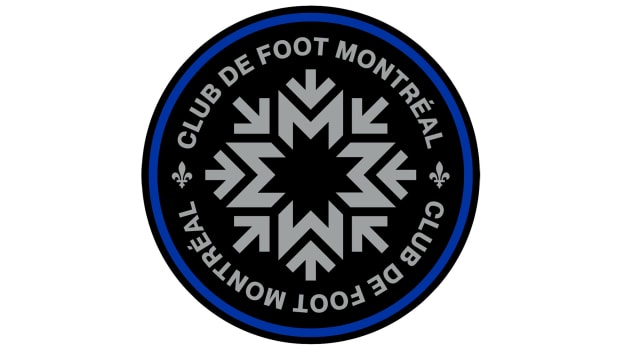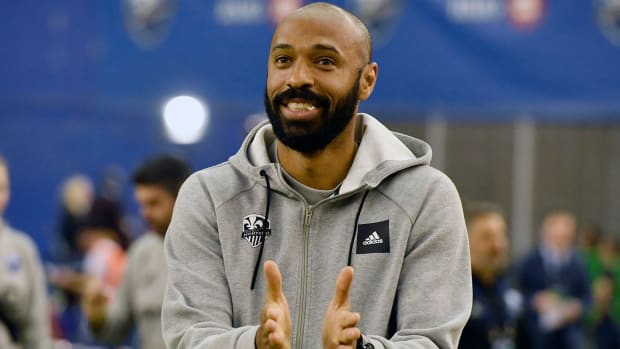Thierry Henry knows a thing or two about an impassioned response to a rebrand–and the best way to get all on board.
Thierry Henry remembers well the response in 2002 when his club, Arsenal, revamped its famous crest, streamlining the shield and font, stripping away the motto and ermine texture and turning the iconic cannon to the right. It was a dramatic evolution from an almost medieval feel to something clean and corporate.
“When that happened, fans were going crazy, and it can take a minute for everyone to understand what is happening. … Some people were upset because they had tattoos of the old badge,” Henry recalled. “I do understand how people feel about something that they feel belongs to them.”
But the club, he argued, still belonged to them. Only the logo had changed. In fact, it had changed many times before. Arsenal's website lists that new crest as its 10th. Tradition can be found wherever you look for it, and it turned out that at Arsenal, change wasn’t so foreign. Four years later, it would leave Highbury for Emirates Stadium.
“When you look at the history of the club, Arsenal changed their crest a lot. It’s still part of the history of the club because it was the crest of the club. It doesn’t change what the club is,” Henry told Sports Illustrated. “People change the names of their stadium. They change towns sometimes. It was just an evolution.”
Change is a well-established phenomenon and strategy in MLS, a 25-year-old league in which only one of the 10 original clubs still uses its first logo and in which seven teams have used at least three. But Thursday’s rebranding of the old Montreal Impact, the club Henry manages, was significant because it involved the elimination of a name that’s older than the league itself. The Impact first took the field in 1993 and won three second-tier championships before entering MLS in 2012. There’s tradition behind that name—not a century’s worth like at Arsenal—but enough to bind a couple generations and evoke lasting and meaningful memories. And now it’s gone, replaced by Club de Foot Montreal. The logo, used since ’13, has changed is well. The new circular badge features four Ms and arrows arranged in a snowflake pattern.

How significant was it? The club asked its iconic coach to call the press from his home in London. Managers typically don’t concern themselves with marketing, but this change was more than cosmetic. It represented a departure from nearly three decades of history.
“Obviously the president and the owner, when those guys are not there I’m the leader of the pack. I’m the captain of the boat. It’s just something normal that I show interest in what’s happening because I’m here,” Henry said. “People may have some difficulty understanding it, but that doesn’t change where the club wants to go from what we were. I was at Arsenal when we changed the crest and a lot of people were upset. Now, nobody talks about the crest anymore. It’s just normal.”
What do you do if there’s a part of your tradition that begins to feel like a bit of a burden? The name ‘Impact,’ while established, felt to some like a relic of its time, one of those nondescript, amorphous 1990s names that didn’t really mean much and sounded perfect for arena football. It certainly wasn’t modern. It probably didn’t make sense beyond North American borders. And it obscured the power of the Montreal brand, which club owner Joey Saputo and president Kevin Gilmore wanted front and center.
The rebranding initiative started some two years ago. They enlisted local creative director Justin Kingsley, who worked on branding for the 2015 Women’s World Cup and the 2026 United Bid, among other projects, to lead the effort.
“We didn’t cast all that [history] away, but we realized that in 2021 and beyond, with digital technology allowing us to communicate with anyone on the planet in milliseconds, we needed an image that resonated globally,” Kingsley said. “People around the globe don’t know the name ‘Impact.’ It doesn’t resonate with them. I know Montreal resonates with them.”
Henry said that “Club de Foot” fits naturally with how French speakers refer to the sport, and it follows the MLS trend of eliminating nicknames or mascots from club identities. The new logo conforms in some ways and stands out in others. The circular shape and heavy use of black fit right in in MLS. The ‘M’ snowflake motif and fleur-de-lis, however, do represent Montreal. The arrows recall the Montreal Metro logo, and the snowflake image is meant to symbolize the power of the city’s multicultural unity.
“No two of us are alike but together, we are an unstoppable force of nature,” it says in the club’s branding guide.
The blue border represents the waters surrounding the Île de Montréal. It gets mostly lost amid the black, however, as CF Montreal bows to whatever relentless pressure seems to be put on MLS clubs to prioritize that color. Expect the distinctive blue-and-black stripes the Impact featured on its primary jersey for the past five seasons to disappear along with the old name.
“All colors combined make black,” Kingsley said. “It’s a metaphor for our story. It’s key to the makeup of the city. Think about our nightlife. People come to Montreal for what happens in the dark.”
The club’s new uniforms should be revealed next month.

It’s unclear whether Henry will be back on the field by then, as the start date of MLS preseason is uncertain while the league and its players appear to be embarking on yet another round of labor negotiations. In its final campaign as the Impact—Henry’s first as manager—the club finished ninth in the Eastern Conference at 8-13-2 and bowed out to the New England Revolution in the first round of the playoffs. It was the season following the departure of Montreal legend Ignacio Piatti and it marked a shift in eras. Henry is focusing on youth, culture and development. Kenyan defensive midfielder Victor Wanyama is currently CFM’s only Designated Player.
“When you lose a legend like Piatti, it’s not easy. When you lose [September departure] Saphir Taïder, it’s not easy. But the team came together to save what we could save at the end,” Henry said. “We’re going to have to wait and see what those young guys are going to give us and what we can do, but it’s always been about the team. … This is a process. It doesn’t happen overnight.”
Nor does acceptance of a new identity. The time that takes will pass, however. Henry said he’s sure of it. And if CF Montreal starts to win, it’ll happen even faster.
“There’s nothing bigger than actually the owner accepting it, because he was part of everything right from the start. If he felt he could change, if he can understand and accept that, I think people will understand and accept it as long as they can see that we’re moving forward. When people see their team performing, they’ll like it,” Henry concluded. “When you win, you’re right. When you’re successful, people come along, no matter what.”